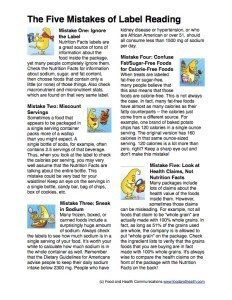The 5 Mistakes of Label Reading
Skip these common label reading errors!Mistake One: Ignore the LabelNutrition Facts labels are a great source of tons of information about the food inside the package, yet many people completely ignore them. Check the Nutrition Facts for information about sodium, sugar, and fat content, then choose foods that contain only a little (or none) of those things. Also check macronutrient and micronutrient stats, which are found on that very same label.Mistake Two: Miscount ServingsSometimes a food that appears to be packaged in a single serving container packs more of a wallop than you might expect. A single bottle of soda, for example, often contains 2.5 servings of that beverage. Thus, when you look at the label to check the calories per serving, you may very well assume that the Nutrition Facts are talking about the entire bottle. This mistake could be very bad for your waistline! Keep an eye on the servings in a single bottle, candy bar, bag of chips, box of cookies, etc.Mistake Three: Sneak in SodiumMany frozen, boxed, or canned foods include a surprisingly huge amount of sodium. Always check the labels to see how much sodium is in a single serving of your food. It’s worth your while to calculate how much sodium is in the whole container as well. Remember that the Dietary Guidelines for Americans advise people to keep their daily sodium intake below 2300 mg. People who have kidney disease or hypertension, or who are African American or over 51, should all consume less than 1500 mg of sodium per day.Mistake Four: Confuse Fat/Sugar-Free Foods for Calorie-Free FoodsWhen treats are labeled fat-free or sugar-free, many people believe that this also means that those foods are calorie-free. This is not always the case. In fact, many fat-free foods have almost as many calories as their fatty counterparts -- the calories just come from a different source. For example, one brand of baked potato chips has 120 calories in a single ounce serving. The original version has 160 calories in that same ounce-sized serving. 120 calories is a lot more than zero, right? Keep a sharp eye out and don’t make this mistake!Mistake Five: Look at Health Claims, Not Nutrition FactsMany packages include lots of claims about the health value of the foods inside them. However, sometimes those claims can be misleading. For example, not all foods that claim to be “whole grain” are actually made with 100% whole grains. In fact, as long as 51% of the grains used are whole, the company is is allowed to put “whole grain” on the package. Check the ingredient lists to verify that the grains foods that you are buying are in fact made with 100% whole grains. It’s always wise to compare the health claims on the front of the package with the Nutrition Facts on the back!Here's the free printable nutrition handout for this post! And here are some other Nutrition Facts label resources from the Nutrition Education Store![shopify embed_type="product" shop="nutrition-education-store.myshopify.com" product_handle="food-label-lab-dissecting-the-truth-about-food-labels" show="all"][shopify embed_type="product" shop="nutrition-education-store.myshopify.com" product_handle="label-reading-poster-set" show="all"][shopify embed_type="product" shop="nutrition-education-store.myshopify.com" product_handle="food-label-bookmarks-pack-of-50-2x7" show="all"]
And here are some other Nutrition Facts label resources from the Nutrition Education Store![shopify embed_type="product" shop="nutrition-education-store.myshopify.com" product_handle="food-label-lab-dissecting-the-truth-about-food-labels" show="all"][shopify embed_type="product" shop="nutrition-education-store.myshopify.com" product_handle="label-reading-poster-set" show="all"][shopify embed_type="product" shop="nutrition-education-store.myshopify.com" product_handle="food-label-bookmarks-pack-of-50-2x7" show="all"]


